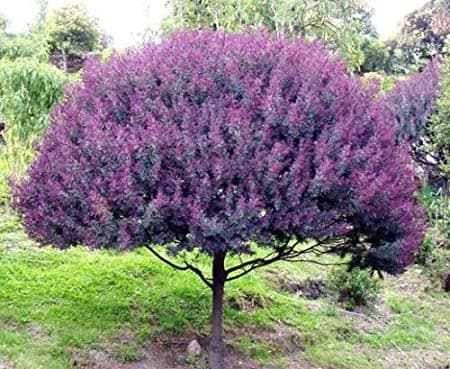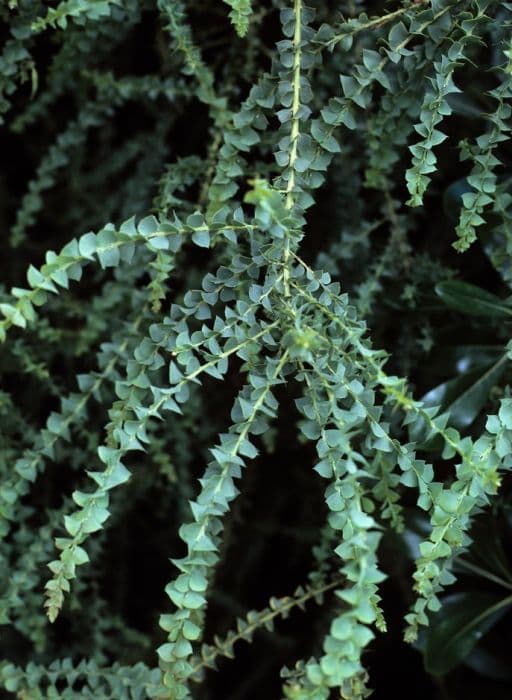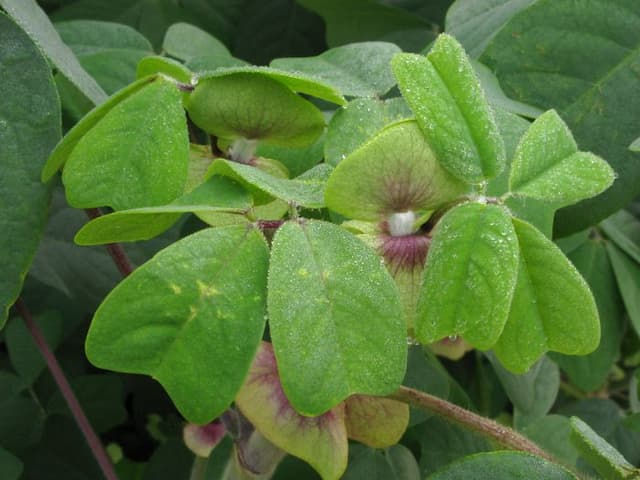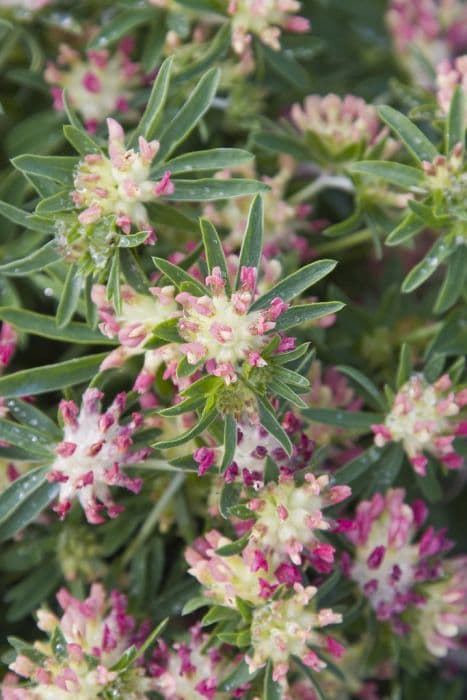Blue lupin Lupinus angustifolius

ABOUT
The plant known as blue lupin displays a distinct appearance marked by its signature spikes of blue flowers. These flowers are densely packed on a tall stalk that rises from the plant's base. Each individual blossom is small and shaped somewhat like a pea flower; it exhibits a standard banner, wings, and a keel, as is typical for flowers in the legume family. The foliage of blue lupin is equally striking, with leaves that are palmately compound, meaning they consist of multiple leaflets arranged in a circular pattern that radiates out from a single point like the fingers of a hand. The leaflets are narrow and typically come in multiples of 5 to 9 per leaf, with a smooth or slightly hairy texture. Overall, the plant's foliage presents a grayish-green hue, which contrasts nicely with the vibrant blue flowers. The stems of the blue lupin are sturdy and often have a hairy texture, which helps support the weight of the flowers and leaves. The plant also produces pods after flowering, which contain seeds that allow for its propagation. The pods are usually hairy and can be quite prominent when mature, depending on the variety. Throughout its blooming period, blue lupin adds a splash of color to gardens and wild areas, attracting pollinators like bees with its brightly colored flowers and contributing to the beauty of the landscape with its unique foliage and structural form.
About this plant
 Names
NamesFamily
Fabaceae
Synonyms
Narrow-Leafed Lupin, Blue Lupin, Narrow-Leaved Lupin, Australian Sweet Lupin, New Zealand Blue Lupin
Common names
Lupinus angustifolius, Lupinus linifolius Roth, Lupinus angustifolius var. reticulatus Regel, Lupinus reticulatus (Regel) Kuntze.
 Toxicity
ToxicityTo humans
The plant commonly known as blue lupin has seeds that contain alkaloids, which can be toxic to humans if ingested in large quantities. The toxicity can cause symptoms such as bitter taste, vomiting, respiratory depression, and dizziness. Chronic ingestion might lead to more severe neurological conditions, including convulsions. Proper processing of the seeds, including soaking and cooking, is essential to reduce the alkaloid content and lower the risk of poisoning.
To pets
Blue lupin is also toxic to pets, including dogs and cats, due to its alkaloid content. If pets ingest parts of this plant, they can exhibit symptoms of poisoning such as lethargy, vomiting, diarrhea, tremors, and convulsions. Severe poisoning could potentially lead to respiratory failure and death. It is critical to prevent pets from ingesting this plant and to consult a veterinarian immediately if ingestion is suspected.
 Characteristics
CharacteristicsLife cycle
Annuals
Foliage type
Deciduous
Color of leaves
Green
Flower color
Varies
Height
3 feet (0.91 meters)
Spread
2 feet (0.61 meters)
Plant type
Herb
Hardiness zones
4
Native area
Mediterranean
Benefits
 General Benefits
General Benefits- Soil Improvement: The plant has nitrogen-fixing abilities, which enrich the soil and reduce the need for chemical fertilizers.
- Forage for Animals: It serves as high-protein feed for livestock, particularly sheep and cattle.
- Erosion Control: Its vigorous root system helps stabilize soil and prevent erosion.
- Green Manure: It can be used as a cover crop to improve soil structure and fertility when ploughed back into the soil.
- Biodiversity Support: It provides habitat and food sources for a variety of wildlife, including bees and other pollinators.
- Agricultural Benefits: Lupinus angustifolius can be part of crop rotation schemes to break disease cycles of other crops.
- Landscape Beautification: Its bright blue flowers can enhance the visual appeal of an area.
- Companion Planting: Some farmers and gardeners use it to intercrop with other plants to take advantage of its nitrogen-fixing property.
 Medical Properties
Medical Properties- Antioxidant activity: Lupinus angustifolius contains compounds that may exhibit antioxidant properties, helping to neutralize free radicals in the body.
- Anti-inflammatory effects: Some research suggests that bioactive peptides derived from Lupinus angustifolius may have anti-inflammatory potential.
- Glycemic control: Lupinus angustifolius has been investigated for its potential in improving glycemic control, which could be beneficial for individuals with type 2 diabetes.
- Cholesterol-lowering effects: Consumption of Lupinus angustifolius has been linked to reductions in blood cholesterol levels due to its high dietary fiber and protein content.
 Air-purifying Qualities
Air-purifying QualitiesThis plant is not specifically known for air purifying qualities.
 Other Uses
Other Uses- Lupinus angustifolius, commonly known as blue lupin, seeds can be used as a high-protein, gluten-free food alternative. They can be eaten after soaking and boiling to remove alkaloids.
- The stems and fibers of blue lupin can be utilized in the production of biodegradable plastics, providing a more sustainable material option.
- Blue lupin flowers are sometimes used in floral arrangements and gardening for ornamental purposes due to their vivid blue-purple coloration and attractive spikes.
- As a green manure crop, blue lupin can be plowed into the soil to improve its fertility, structure, and organic content.
- Blue lupin, due to its deep-rooting system, can be planted to prevent soil erosion and stabilize embankments and dunes.
- The plant has potential use in phytoremediation, helping to detoxify soils contaminated with certain heavy metals.
- In crop rotation, blue lupin is sometimes used as a break crop to disrupt pest and disease cycles.
- Due to its nitrogen-fixing capability, blue lupin can be part of permaculture designs to reduce the need for synthetic fertilizers.
- Blue lupin seed pods can be utilized in botanical crafts and as educational tools in botany and natural history studies.
- When used in companion planting, blue lupin can benefit neighboring plants by increasing nitrogen availability in the soil.
Interesting Facts
 Feng Shui
Feng ShuiThe Blue Lupin is not used in Feng Shui practice.
 Zodiac Sign Compitability
Zodiac Sign CompitabilityThe Blue Lupin is not used in astrology practice.
 Plant Symbolism
Plant Symbolism- Imagination: Lupinus angustifolius, commonly known as blue lupin, is often associated with imagination due to its vibrant colors and unique floral spikes that inspire creativity.
- Admiration: The striking appearance of blue lupin can symbolize admiration and the acknowledgment of someone's uniqueness and special qualities.
- Happiness: The bright blooms of blue lupin are said to bring joy and happiness, making it a positive emblem in floral language.
- Transformation: Lupins undergo a significant transformation from seed to flower, which symbolizes the ability to change and adapt in life.
- Opportunity: The prolific nature of blue lupin's growth signifies seizing opportunities and the idea that new ventures can flourish.
 Water
WaterThe common name for Lupinus angustifolius is narrowleaf lupine, which requires regular watering to maintain moist soil, particularly during its growing season in the spring and early summer. It should be watered deeply once or twice a week, depending on the climate and soil type, with a general guide of approximately 1 inch of water each time, which equates to roughly 0.623 gallons per square foot over a week. However, be cautious to not overwater, as this can lead to root rot. During hot summers or periods of drought, water needs may increase. Always check the top inch of soil for dryness before watering again to prevent over-saturation.
 Light
LightNarrowleaf lupine thrives in full sun, meaning it needs at least 6 to 8 hours of direct sunlight per day. The best spot for this plant is an area where it will benefit from clear, unfiltered sunlight throughout the day. Partial shade can be tolerated, but too much shade may reduce blooming and weaken the plant.
 Temperature
TemperatureNarrowleaf lupine prefers a cooler climate and can tolerate temperatures as low as 20 degrees Fahrenheit but may be damaged by temperatures below this point. The ideal temperature range for narrowleaf lupine is between 60 to 75 degrees Fahrenheit during the growing season. This plant can survive in temperatures up to 85 degrees Fahrenheit but may require additional watering to cope with the heat.
 Pruning
PruningPruning narrowleaf lupine is essential to promote bushiness and prevent legginess. The best time for pruning is early spring or after flowering to encourage a second bloom. Prune your lupine lightly by cutting back by one-third after the initial bloom fades to stimulate new growth and additional flowering. Deadheading spent flowers will also help in maintaining a neat appearance and may prolong the blooming period.
 Cleaning
CleaningAs needed
 Soil
SoilFor Blue Lupin, the best soil mix is well-draining with added organic matter such as compost. It prefers a slightly acidic to neutral pH, ranging between 6.0 and 7.0. Drainage is crucial to prevent root rot.
 Repotting
RepottingBlue Lupin does not generally need to be repotted as it is an annual plant; however, if growing as a perennial, repot every 2-3 years to refresh the soil.
 Humidity & Misting
Humidity & MistingBlue Lupin thrives in average garden humidity levels and does not require any special humidity considerations.
 Suitable locations
Suitable locationsIndoor
Use bright, indirect light and well-draining soil for indoor Blue Lupin.
Outdoor
Plant in full sun and well-draining soil for outdoor Blue Lupin growth.
Hardiness zone
3-9 USDA
 Life cycle
Life cycleNarrow-leaved lupin (Lupinus angustifolius) begins its life as a seed, which germinates in favorable conditions of warmth and moisture, forming a small seedling with a pair of embryonic leaves known as cotyledons. As the seedling matures, true leaves emerge, and it develops into a vegetative state, characterized by a spurt of foliage growth. Following the vegetative stage, the plant enters the reproductive phase, where it develops inflorescences and produces distinctive colorful flowers, typically in shades of blue, purple, or white. After pollination, often by bees, the flowers develop into seed pods, which mature and eventually release their seeds when the pods split open. These seeds can lie dormant in the soil over winter or until conditions are right for germination, thus completing the lifecycle. The mature plant may die after seed set, especially if it's an annual variety, or it might survive for several years if it's perennial.
 Propogation
PropogationPropogation time
Spring
Propogation: The most popular method of propagating Lupinus angustifolius, commonly known as narrow-leafed lupin, is through seed sowing. The best time for sowing lupin seeds is in spring, after the last frost has passed, to allow the plant to establish through the warm months. Seeds require scarification, which is the process of scratching or softening the hard seed coat to encourage germination. This can be done by gently rubbing the seeds with sandpaper or nicking them with a knife. Once scarified, the seeds are soaked in water for a period of 12 to 24 hours, which helps to further break down the seed coat and stimulate germination. Following the soaking period, seeds are sown at a depth of about 1/4 to 1/2 inch (about 6 to 13 mm) in a well-draining soil mix. The soil should be kept moist but not waterlogged, and seedlings typically emerge within 14 to 20 days.









